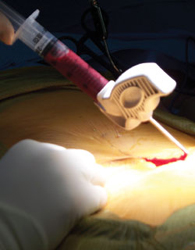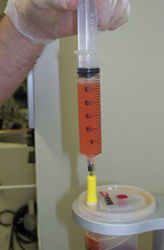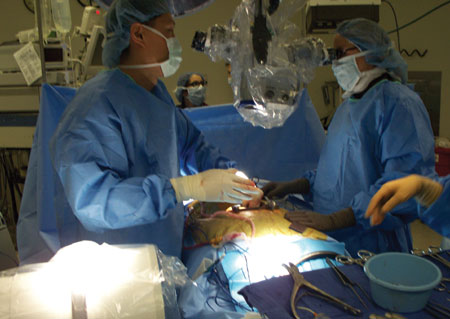Spine surgeon sees good prospects for eventual use of stem cells in fusion surgery
The positive effect stem cells had on bone formation in animal and human fusion models makes them a possible future clinical option.
On the heels of the decade that saw bone morphogenetic proteins approved for spine fusion in humans, stem cells now hold promise for use in that area, a Los Angeles orthopedic spine surgeon recently said.
At the North American Spine Society 29th Annual Meeting, Jeffrey C. Wang, MD, built a case for the eventual clinical use of stem cells in spine fusion surgery.
“I think they will become important,” he said.
|
|
In his presentation Wang discussed pre-clinical and clinical studies in the literature supporting further investigation into using stem cells for fusion. “I would argue that they already do play an important role,” he said.
But rather than just injecting stem cells at a possible treatment site, he anticipated they will likely be used in combination with such adjuncts as carriers and growth factors, like bone morphogenetic protein (BMP).
Wang reviewed some studies in rabbits and dogs that used stem cells for spine fusion or autograft enhancement.
“There are a host of studies showing a positive effect on bone formation … when you add in bone marrow,” he added.
Human trials
Concerning human studies using stem cells in the spine, Wang mentioned a trial where they were used in a robust environment: adolescent scoliosis cases. He said with allograft alone these fusions would have likely healed, “but certainly this study shows the use of cells is a viable graft replacement.”
Together, these studies make a strong argument favoring stem cell use in spine fusion, Wang said. “When you look at the recent literature, there is an overwhelming amount of data showing that stem cells are going to be important for the future.”
|
|
|
Images: Wang JC |
Role of stem cells
Wang discussed the possible benefits he sees from adding stem cells during human spine fusion surgery, including to:
- help bone heal more naturally;
- enhance the action of growth factors;
- prevent the complications currently associated with BMP use in the spine; and
- decrease the need for growth factors, like BMP.
“Perhaps using stem cells, we might be able to decrease the dose of some of these growth factors and perhaps reduce the complications,” Wang said, noting that the greatest potential for stem cells seem to be working in tandem with growth factors rather than being used as a standalone approach.
|
|
Yet another reason Wang sees stem cell technology gaining wider use is the relative ease of obtaining stem cells from the pedicles, vertebral bodies or iliac crest.
“We may even have allograft cells in the future that can be used even more readily.” — by Susan M. Rapp
References:
- Shah SA, Borkkuu B, Littleton AG, et al. Can a bone marrow-based graft replacement result in similar fusion rates as rib autograft in anterior interbody fusion procedures for adolescent thoracolumbar scoliosis? J Spinal Disord Tech. 2010;23(1):57-62.
- Wang JC. Preclinical and clinical data on stem cells in spine fusion; and Why stem cells will become more important in clinical practice for spinal fusion. Both presented at the North American Spine Society 24th Annual Meeting. Nov 11-14, 2009. San Francisco.
- Jeffrey C. Wang, MD, can be reached at the UCLA Comprehensive Spine Center, 1250 16th St., Suite 745, Santa Monica, CA 90404; 310-319-3334; e-mail: jwang@mednet.ucla.edu.
From my experience and our university’s cell-based research in disc regeneration and bone metabolism, I know it’s difficult to get biologic products through the arduous FDA process. I have followed the Geron study closely and noticed it had false starts even before researchers observed epithelial inclusion cysts in the rats studied leading to a delay in study commencement.
Furthermore, for spine fusions you need a cell that is a little bit down the lineage so that what it’s going to differentiate into is more clearly defined. Despite that, the cell still has the potential to go off into different directions. So if it took this long to get Geron’s study for spinal cord regeneration going, a condition for which there is no definite cure, with so many alternatives available for spine fusion, I think the FDA will be really strict about approving cell based technologies that have the potential to go awry.
Another reason stem cells may not reach clinical use is their potential to do things they are not programmed to do. Based on case reports in the literature, in occult cancer cases, for example, stem cells have a proclivity to find an aberrant cell, assume its DNA machinery and then become what that tumor is. Thus, a sarcoma cell that is not clinically evident could become activated or the stem cell could become a sarcoma cell.
My third argument is when you grow stem cells over and over again, they tend to lose their cell-to-cell inhibitory cues and may become the kind of cell you don’t want them to be. With all these obstacles to their use, I doubt that anytime soon we will be injecting stem cells into a fusion mass to enhance fusions.
— Alexander R. Vaccaro, MD, PhD,
FACS
Professor of Orthopedic Surgery and Neurosurgery
Thomas
Jefferson University Hospital, Philadelphia





